Indonesia is stepping up its commitment to renewable energy with ambitious plans to increase solar power capacity. PLN Indonesia Power (PLN IP), a subsidiary of the country’s state-owned electricity giant, has announced the expansion of its solar panel factory to support Indonesia’s target of 17.1 gigawatts (GW) of installed solar power.
This move marks a critical milestone in the nation’s long-term energy strategy and reflects the growing importance of local solar panel manufacturing in meeting clean energy goals while reducing import dependency. Here’s how this effort could reshape Indonesia’s renewable energy landscape.
Indonesia’s Solar Energy Ambitions
Indonesia’s National Energy Policy outlines a vision to generate 23% of its total energy mix from renewable sources by 2025. Of this, solar energy is expected to contribute 17.1 GW—a substantial leap from its current solar power capacity, which remains under 1 GW in operation.
To achieve this, the country must scale both generation and manufacturing. PLN Indonesia Power is now working to fill this gap by expanding the capacity of its solar panel factory, which plays a vital role in supplying equipment for future solar power plants across the archipelago.
This expansion aligns with government directives to accelerate local industrial capabilities in the green energy sector.
PLN IP’s Role in Building Green Infrastructure
PLN IP, one of the core units under PT PLN (Persero), is at the forefront of Indonesia’s transition to cleaner energy. It manages power generation assets and is now also investing in renewable energy infrastructure, including solar, hydro, and geothermal.
By expanding its solar panel factory, PLN IP aims to achieve several objectives:
- Increase local production of photovoltaic (PV) panels and reduce reliance on imports, especially from China.
- Lower the cost of solar project development through local manufacturing efficiencies.
- Ensure faster deployment of solar power plants by integrating the supply chain.
- Create green jobs in the manufacturing and renewable energy sectors.
While PLN has not disclosed the exact scale of the expansion, the company confirms that the project is in line with Indonesia’s 17.1 GW solar energy roadmap and will be located in an industrial zone that supports logistics and export.
Solar Panel Manufacturing: A Strategic Pillar
Indonesia currently relies on imported solar modules for most of its projects, which exposes developers to price volatility and shipping delays. Strengthening solar panel factory Indonesia capabilities is essential to:
- Meet domestic demand as the market scales rapidly
- Position Indonesia as a regional manufacturing hub for Southeast Asia
- Build technological independence in renewable energy components
Industry experts estimate that to meet the 17.1 GW solar target, Indonesia will require between 25 million to 30 million solar panels, depending on system design. Having domestic production capacity not only helps meet this demand but also supports local innovation and research in clean energy tech.
Key Challenges in Scaling Up
Despite its potential, Indonesia’s solar sector faces several hurdles:
1. Limited Local Manufacturing Capacity
Before PLN IP’s expansion, only a handful of domestic producers existed, and many operated below full capacity. Additional investments are needed to build upstream capabilities like solar cells, not just modules.
2. Financing Solar Projects
Investors often cite regulatory uncertainty and low returns on solar projects as barriers. To support factory demand, solar installations must be financially attractive, which depends on feed-in tariffs and procurement transparency.
3. Skilled Workforce Shortage
The rapid expansion of renewable energy infrastructure requires trained technicians, engineers, and production workers. Upskilling programs and partnerships with vocational institutions will be essential.
4. Grid Integration
Deploying 17.1 GW of solar energy will place new stress on the national grid. PLN must also invest in energy storage and smart grid technologies to accommodate intermittent solar generation.
The Broader Impact on Indonesia’s Green Economy
Expanding the solar panel factory Indonesia is more than an infrastructure move—it’s a signal of a broader economic transition. With the right policies and coordination, Indonesia could benefit from:
- Job creation across manufacturing, construction, and solar operations
- Technology transfer through joint ventures with global solar firms
- Export potential for solar modules to ASEAN and Oceania markets
- Environmental benefits through reduced carbon emissions and fossil fuel dependency
Indonesia’s Ministry of Energy and Mineral Resources (ESDM) has also pledged to simplify licensing procedures for renewable energy projects and offer fiscal incentives for solar equipment manufacturers.
Industry Collaboration and Partnerships
To meet its targets, PLN IP is expected to collaborate with local and international partners. Some potential initiatives include:
- Public-private partnerships to co-invest in manufacturing infrastructure
- Joint R&D centers to enhance solar panel efficiency and adapt technology to Indonesia’s tropical climate
- Supply chain development programs to support small and medium enterprises in producing components like inverters, frames, and cabling
These partnerships will also foster workforce development and innovation across the ecosystem.
Conclusion
Indonesia’s path to 17.1 GW of solar power hinges not just on building more solar farms, but also on scaling up its domestic production of solar panels. The expansion of PLN IP’s solar panel factory signals a critical shift in strategy—from import dependency to self-reliance and industrial strength in green technology.
By focusing on solar panel factory Indonesia development, the country is not only accelerating its clean energy goals but also laying the foundation for a green manufacturing economy. With the right incentives, partnerships, and workforce support, Indonesia could emerge as a solar power leader in the region.
Read More






 Wednesday, 03-12-25
Wednesday, 03-12-25







